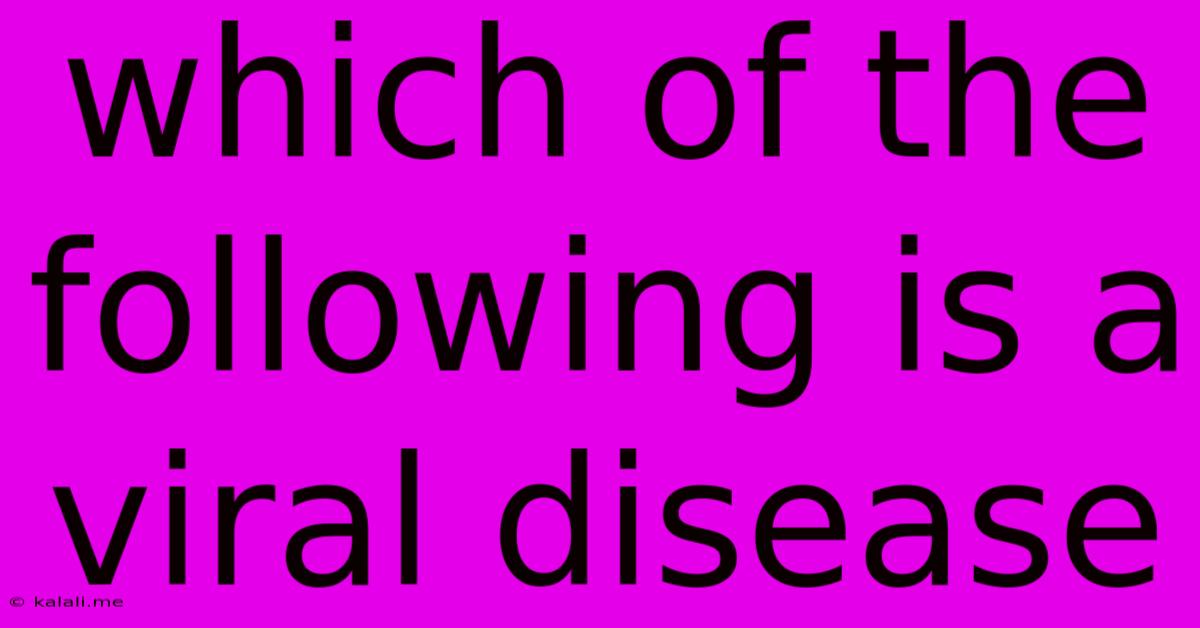Which Of The Following Is A Viral Disease
Kalali
Jun 13, 2025 · 3 min read

Table of Contents
Which of the Following is a Viral Disease? Understanding Viral Infections
This article will explore what constitutes a viral disease and provide examples to help you understand how viruses cause illness. Understanding viral infections is crucial for preventing the spread of disease and making informed decisions about your health. This article will delve into the characteristics of viral diseases, differentiate them from other types of infections, and provide clear examples.
What is a Viral Disease?
A viral disease is an illness caused by a virus. Viruses are microscopic infectious agents that replicate inside the living cells of an organism. Unlike bacteria, which are self-sufficient single-celled organisms, viruses are obligate intracellular parasites, meaning they need a host cell to survive and reproduce. This parasitic nature is what makes viral infections so challenging to treat. Once a virus has infected a host cell, it hijacks the cell's machinery to create more viruses, often leading to cell damage and the symptoms we associate with viral illnesses.
Key Characteristics of Viral Diseases:
- Infectious Nature: Viral diseases are highly contagious, spreading easily through various routes like airborne droplets (coughing, sneezing), direct contact (touching infected surfaces), or bodily fluids.
- Specificity: Viruses are often specific to certain host cells or even species. For instance, the human immunodeficiency virus (HIV) infects human cells, while canine parvovirus infects dogs.
- Incubation Period: There's usually a period between infection and the appearance of symptoms (the incubation period), which can vary widely depending on the virus.
- Immune Response: The body's immune system plays a crucial role in fighting viral infections. This response can involve fever, inflammation, and the production of antibodies to neutralize the virus.
- Treatment Challenges: Because viruses hijack host cells, treating viral infections is often more complex than treating bacterial infections. Antibiotics are ineffective against viruses; antiviral medications target specific viral processes, but they don't always eliminate the virus completely.
Examples of Viral Diseases:
Many common illnesses are caused by viruses. Here are a few examples, categorized for clarity:
Respiratory Viruses:
- Influenza (Flu): Characterized by fever, cough, sore throat, and muscle aches. Multiple strains exist, necessitating annual vaccination.
- Common Cold (Rhinovirus): Similar symptoms to the flu, but generally milder.
- Respiratory Syncytial Virus (RSV): Primarily affects infants and young children, causing bronchiolitis and pneumonia.
Gastrointestinal Viruses:
- Norovirus: Causes vomiting and diarrhea, often associated with outbreaks in cruise ships and other crowded settings.
- Rotavirus: Another common cause of gastroenteritis, particularly in children.
Other Viral Diseases:
- Measles: A highly contagious disease characterized by a distinctive rash.
- Mumps: Causes swelling of the salivary glands.
- Rubella: Can cause serious complications during pregnancy.
- Chickenpox (Varicella): Characterized by itchy blisters.
- Herpes Simplex Virus (HSV): Causes cold sores and genital herpes.
- Human Immunodeficiency Virus (HIV): Attacks the immune system, leading to Acquired Immunodeficiency Syndrome (AIDS).
- Human Papillomavirus (HPV): Can cause genital warts and certain types of cancer.
Differentiating Viral from Other Illnesses:
It's important to distinguish viral infections from other types of illnesses, such as bacterial or fungal infections. Bacterial infections can often be treated with antibiotics, while viral infections typically require supportive care to manage symptoms until the body's immune system overcomes the infection. Fungal infections also have different treatments and presentations. A healthcare professional can properly diagnose the cause of your illness.
This article provides a general overview. Always consult a medical professional for diagnosis and treatment of any illness. They can accurately determine if your symptoms are caused by a virus and recommend appropriate care.
Latest Posts
Latest Posts
-
Noses Have The Smallest Bones In The Human Body
Jun 14, 2025
-
Culinary Institute Of America Gpa Requirements
Jun 14, 2025
-
The Distinction Between A Normal And An Inferior Good Is
Jun 14, 2025
-
Appreciation Letter For Hard Work And Dedication
Jun 14, 2025
-
Match The Type Of Glacial Deposit With Its Correct Characteristics
Jun 14, 2025
Related Post
Thank you for visiting our website which covers about Which Of The Following Is A Viral Disease . We hope the information provided has been useful to you. Feel free to contact us if you have any questions or need further assistance. See you next time and don't miss to bookmark.